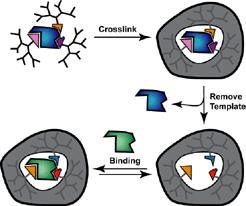Synthetic hosts via molecular imprinting—are universal synthetic antibodies realistically possible?
Abstract
Of the many ways to make synthetic hosts, one of the most appealing involves molecular imprinting. In the commonest approach monomer units assemble around or are attached to a template (imprint) molecule and then linked together using a cross-linking agent. Template removal ideally leaves cavities within the molecularly imprinted


 Please wait while we load your content...
Please wait while we load your content...